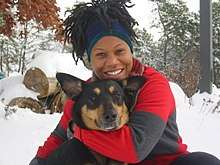Interspecies friendship
.jpg)
An interspecies friendship is a bond that is formed between animals of different species. Domestication of animals has led to very unusual interspecies friendships between two (or more) species that would naturally never exist together otherwise. Domestication is defined as a multi-generational relationship in which one group of organisms assumes a significant degree of influence over the reproduction and care of another group to secure a more predictable supply of resources from that second group.[1] Numerous cases have been reported among wild and domesticated animals and documented with photography and video.
In the previous 11,000 years, humans have brought a wide range of various species into domestication. Reasons included animals as livestock, working animals, household pets, and companions.[2] Interspecies friendships have been reported and recorded between numerous varieties of animal species including mammals, birds, reptiles, and combinations of these. In many cases, the pairs of animals include those not known to get along, and sometimes, one is of a species that ordinarily preys upon the other in nature. Nevertheless, the influence of human behaviour on domesticated animals has led to many species having learned to co-exist - sometimes even having formed an interspecies friendship.
The concept of interspecies friendship is similar to that of mutualism (biology) in that two individuals from different species exist in a relationship where each organism benefits from the activity of the other. Reasons for interspecies friendships include a mutually beneficial exchange between the pair, desire for social bonding, protection, or is often unknown.
Friendship between human and other animals
Canis familiaris

The relationship between a human and a household dog (Canis familiaris) is quite common and said to be similar to the relationship seen between a parent and child.[3] Many people agree that there is an emotional bond between themselves and their dog.[4] An important indicator of the bond between a dog and its caregiver can be seen through separation and reunion incidences. The behaviour of the dog including approach latency and the frequency of initiating physical contact varies according to how familiar the dog is with the person.[5] This can be viewed as a snapshot of their relationship.[4] Behaviours such as tail wagging, lip licking, body shaking and vocalization also indicate this.[4]
Trait selection and convergent evolution
Animals often portray many similar characteristics displayed by humans. There looms large belief that while both humans and animals evolve simultaneously, domesticated animals have benefitted the most from human-animal relationships because they have increased in population much further than they ever would have in a natural occurrence because of their selected "human-like" characteristics.[6] The selection of behavioural skills provides a typical environment for convergent evolution.
Canis familiaris

There is a wide range of shared general and specific social skills between humans and dogs including functional and behavioural traits. Sociality, the ability to perform synchronized behaviour and complex constructive skills have each been previously displayed in both dogs and humans. For example, qualities of sociality include life-long attachment, reduced intra-group aggression, enhanced cooperation. Whereas, synchronized behaviours include imitation, hypnosis and dance and complex constructive skills include mimesis and language. [7]. Dogs display specific social skills during interaction with humans for their benefit. Advancement in attachment skills for the dogs enables them further benefit from humans by gaining valuable information, protection and help [8].
Animals that have evolved social skills gained close integration with humans and their community resulting in more successful species. Human-dog relationships are the most common interspecies friendships seen in the universe resulting in dogs becoming one of the most successful mammalian species to exist.[7]
References
- ↑ https://en.wikipedia.org/wiki/Domestication
- ↑ Zeder, M. (2012). Pathways to animal domestication. Biodiversity In Agriculture: Domestication, Evolution Andsustainability, 227-59.
- ↑ Serpell, J.A., 2004. Factors influencing human attitudes to animals and theirwelfare. Anim. Welfare 13, 145–151.
- 1 2 3 Rehn, T., & Keeling, L. (2016). Measuring dog-owner relationships: Crossing boundaries between animal behaviour and human psychology. Applied Animal Behaviour Science, 183, 1-9.
- ↑ Rehn, T., McGowan, R., & Keeling, L. (2013). Evaluating the Strange Situation Procedure (SSP) to Assess the Bond between Dogs and Humans. Plos ONE, 8(2), e56938.
- ↑ Hare, B. et al. (2002) The domestication of cognition in dogs. Science 298, 1634–1636.
- 1 2 Miklósi, Á., Topál, J., & Csányi, V. (2007). Big thoughts in small brains? Dogs as a model for understanding human social cognition. Neuroreport, 18(5), 467-471.
- ↑ Ga´csi, M. et al. (2013) Human analogue safe haven effect of the owner: behavioural and heart rate response to stressful social stimuli in dogs. PLoS ONE 8, e58475